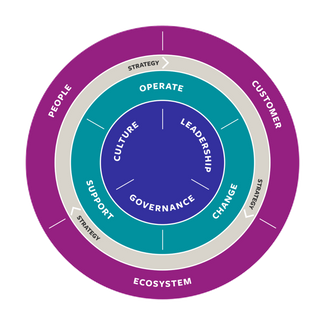Find out what 'good practice' looks like when it comes to business agility
At the Agile Business Consortium, we believe there's no such thing as 'best' practice in business agility. After all, being agile by its very nature implies a journey for continuing improvement. But what examples of good practice can we take from the Agile Business Awards 2023?
The awards, featuring organisations from across the globe, are not about who is the most agile; they are about who has used agility to become a better organisation, providing more value for customers, people and ecosystems.
This blog will summarise the key learnings detailed in our whitepaper: 'Insights from the Agile Business Awards 2023'.
The whitepaper is based on the feedback given by independent reviewers from the perspective of the Framework for Business Agility (FBA), covering.
Strategy, Governance, Culture, Foundations, People, Leadership, and Outcomes. The highest scoring category across the board was Outcomes, with a score of 81, with the lowest being Strategy, at 62.
Key overall learnings
From the report findings, we can conclude the following:
- Business agility is an ever-ongoing journey
- The key to being agile lies in an organisation's culture, leadership and governance
- The purpose of practising agility is to focus on customers, people and ecosystems to deliver better value
- Agile strategy is still a major area for improvement
- Frameworks do not drive success
- It is possible to achieve agility success within functions as well as across them
- But…when scaling is necessary, so is organisation-wide cross-functionality
- Successful scaling requires going beyond frameworks and techniques. It is about scaling a mindset, culture, leadership, and governance, about scaling competencies while focusing on delivering value to customers, ecosystems, and people.
- Agile success does not come from focusing mainly on process or technology. It comes from being sustainably agile
- Doing agile is not sustainable. Being agile is!
- Business agility leads to better outcomes and better-performing organisations/departments
Let's learn more about this by looking first at Outcomes.
Outcomes – 81/100
Outputs are simply what work is done. Outcomes, on the other hand, are all about the value created for 1. Customer, 2. Staff and 3. Ecosystem, i.e. the external stakeholders, social and ecological environment, competition, supply chain, regulators and technology.
Business agility needs first to provide sustainable value to customers, but to do this, you need your staff, so the organisation needs to be valuable to them too!
Of course, you can only be as agile as your business environment — your 'ecosystem', allows you to be so this is also a vital consideration.
The most successful applicants created value for all three of these by focusing on 'people' as the true powerhouse of the organisation and by engaging and collaborating with customers, staff and the ecosystem.
The next joint highest-scoring categories were People and Leadership.
People — 80/100
Business Agility in itself is not a purpose , it should serve the purpose of an organisation by helping it to be resilient, competent, flexible and adaptable. It should help the organisation to constantly increase value to customers, ecosystems and people.
The highest-scoring applications in this category detailed how cross-functional teams were used to organise work. Other successful applicants maintained functional teams, but with much enhanced collaboration, communication and transparency.
HR support and changing HR functions and processes revealed themselves to be crucial to the success of engaging people in the transformation. HR became a coach, a mentor, a facilitator, with the HR department also adapting itself as part of the journey. Some organisations also detailed how they moved from using KPIs (Key Performance Indicators) to OKRs (Objectives and Key Results) to measure and discuss people's successes.
Applicants who had achieved the greatest agile success illustrated the benefits of much closer contact with customers, even bringing them inside teams, something which marked a breakthrough in their performance. This may not be possible in every organisation but establishing one-to-one relationships with those for whom you are providing value is the shortest and most agile learning loop.
Many applicants revealed themselves to still be primarily focused on internal performance instead of external value creation.
Leadership – 80/100
All applicants embraced the importance of the role of leadership in an agile organisation.
Those who scored the most highly, however, made agile leadership an explicit topic within their agility journey, with workshops, training and feedback sessions.
Any successful transformation needs support from the top (strategy sponsor), the bottom and the middle. From the successful applications reviewed, finding the right balance at all levels and ensuring commitment in some organisational form — for example, a guild, a team, a leading coalition, appeared to be crucial for sustainable success.
Most applications reported that feedback was safe both to give and receive in their organisations, with some highlighting the importance of leaders admitting to mistakes and showing vulnerability.
Some organisations however had found it took time to recover after a leader left, indicating the need to build resilience.
One of the Nine Principles of Agile Leadership is 'Leadership lives everywhere in the organisation, but many applicants still expected leadership to come from the top of the hierarchy. They mentioned difficulty in breaking old habits and 'the old hierarchy' as well as leaders failing to actively support change, or even obstructing it.
Foundations - 79

By 'Foundations', we mean the agility of the 'operating system' of the organisation – illustrated in the Framework for Business Agility by the 'operations, change, support' ring.
The highest-scoring organisations tended to be supported by principles and values at their core.
Reviewers saw how these principles formed the guardrails for transformation and observed that in these organisations or departments, there was a vision, or 'North Star' which showed where they needed to go, which valuable outcomes they needed to produce for customers, people and ecosystems, and what their purpose was.
While one basic language and vocabulary was used, there was no 'one size fits all' approach on the use of methods, frameworks, ceremonies and techniques.
All organisations used frameworks and methods to support their journey, adapting these to their specific needs, never just 'implementing them', and ensuring that what was used reflected the mindset, culture and leadership journey.
Some said they had to abandon the implementation of some well-known frameworks and models as their rules, structures, roles and processes 'got in the way' and hampered adaptability, agility or the delivery of value for customers, people and ecosystems. This illustrates the difference between just 'doing Agile' compared to truly 'being agile'. Becoming agile requires every person in an organisation to adopt a new mindset and new behaviours. Agility is not done to people, it is done through people.
Some larger organisations used a transformation team where the agile coaches resided, where learnings were collected and initiated and where communication and guidance were concentrated. Reviewers recognised the value of having such a concentration of expertise.
Culture - 78
'Culture eats strategy for breakfast', Peter Drucker
Whether 'doing agile' or 'being agile', culture is key. This is something all applicants recognised, with each using approaches tailored to their organisations or departments to develop a more agile culture.
Reviewers noted that some applicants had failed to address culture from the start, leading to potential challenges or failure further down the road. Culture is not a structure or process that you can 'implement', but a concept that requires constant attention, trust, open conversation, and 'show-don’t-tell’, i.e., modelling the behaviour you want to see.
Some applicants were more explicit than others in how an agile culture should be established and why; specific aspects mentioned being autonomy, trust and transparency, safety, feedback, diversity and ethics. The most commonly cited approaches were leading by example and role-modelling — not only by those in a formal leadership position but by everyone, including coaches and consultants.
Moving from a more siloed and potentially divisive culture, to a ‘collaborate and cooperate’ culture was in some cases done using gaming, role-playing and by having open and transparent discussions. Some applicants came up with fun examples. Fun is a good way to facilitate safety and open up the room for learning, provided it is not fun simply for the sake of it.
A form of competition was also used in some of the gaming approaches, a method which, while it drives change, could prove harmful, as opposed to the more agile option of collaboration.
In addition, as with leadership, when a key figure or ‘culture bearer’ left the department/organisation, a sliding back to ‘normal’ occurred. One applicant noted that with everything focused on a growth mindset, a certain level of group-think started to exist and diversity of thinking deteriorated, underlining the need to keep a close eye on this.
Governance – 71
Governance was, unsurprisingly, the second lowest-scoring area in the applications. There is perhaps a pervasive view that governance equates to ‘command and control’, when quite the opposite is true.
Governance is universal, pervasive and scaled. It is based on:
- Empowerment — reliant on informed decision making, at the lowest responsible level, which is responsive and at pace
- Alignment — with the purpose and values of the organisation and any appropriate legislation and regulatory boundaries
- Transparency - easy for people internal and external to the organisation to see what is going on and when intervention is needed
Agility in governance reflects a light-touch, flexible approach to decision-making with the oversight needed to ensure an organisation remains aligned with the values and purpose of its sponsors and regulators.
Reviewers found most applications focused on reducing impediments for decision making but failed to take significant steps towards real agile governance, with transparent information shared throughout the organisation.
In quite a lot of applications reviewers saw the remnants of unnecessarily centralised decision making; an old habit which reduces agility.
Strategy – 62
Reviewers scored strategy the lowest among the categories, with only a few applicants managing to reduce and improve their long strategy cycles during COVID. Those who did however, began to reach high quality strategic decisions in just days or weeks instead of quarters or years!
Agile strategy implies rapid transparent information flows, and a tightly aligned line of sight from strategy definition to strategy execution, measuring effect and feeding back.
Many applicants found it difficult to measure strategy success and to close the feedback loop to learn. Information flow, transparency and facilitating quick responses were also tricky, for larger organisations especially, as was basing decisions on information and gathering information through experimentation.
OKRs helped some applicants have the right conversations and create narratives people could embrace. Almost half of the applicants had these ‘North Star’ strategies and convincing narratives.
The Agile Business Consortium is grateful for the participation of all organisations that participate in the Agile Business Awards, and for the learning that their stories inspire.


